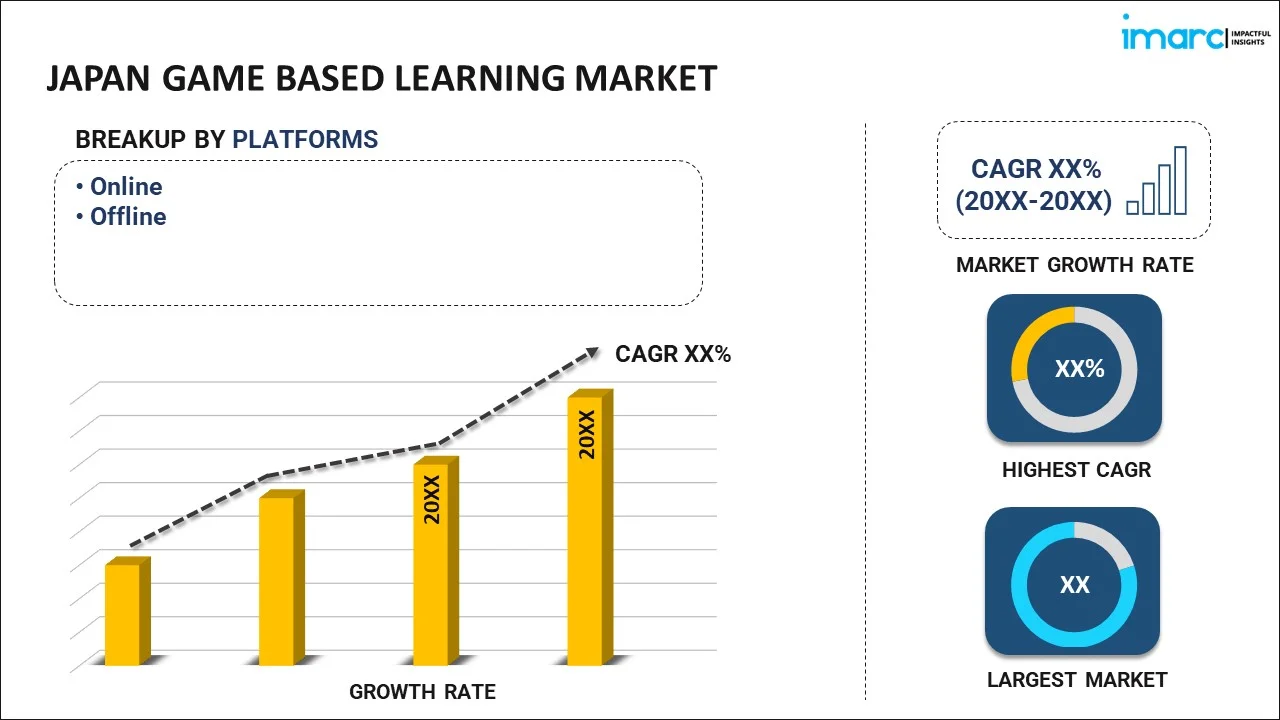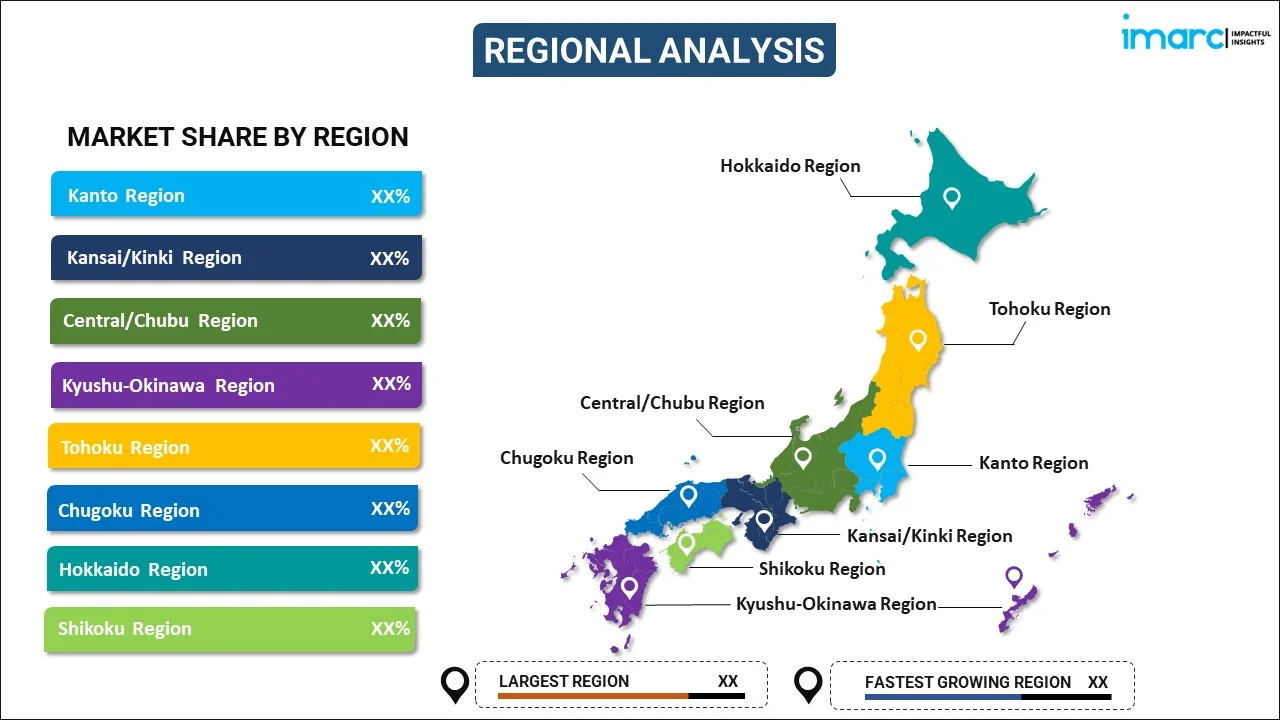
Japan Game Based Learning Market Report by Platform (Online, Offline), Revenue Type (Game Purchase, Advertising, and Others), End User (K-12 Game-Based Learning, Higher Game-Based Learning), and Region 2025-2033
Market Overview:
Japan game based learning market size reached USD 873.3 Million in 2024. Looking forward, IMARC Group expects the market to reach USD 5,039.1 Million by 2033, exhibiting a growth rate (CAGR) of 19.7% during 2025-2033. The market is being driven by several significant factors, including a growing need for more immersive learning experiences, improved educational results, personalized and adaptive learning approaches, corporate training and skill enhancement initiatives, and the increasing prevalence of smartphone use.
|
Report Attribute
|
Key Statistics
|
|---|---|
|
Base Year
|
2024
|
|
Forecast Years
|
2025-2033
|
|
Historical Years
|
2019-2024
|
| Market Size in 2024 | USD 873.3 Million |
| Market Forecast in 2033 | USD 5,039.1 Million |
| Market Growth Rate 2025-2033 | 19.7% |
Game-based learning is an educational strategy that employs interactive games to facilitate the process of learning and skill acquisition. Within this framework, learners participate in game scenarios and activities that have been specifically designed to align with defined educational goals. By incorporating game elements such as challenges, rewards, and progression, this approach motivates participants to actively engage in the learning journey. The primary objective of game-based learning is to enrich the learning experience by encouraging active participation, honing problem-solving abilities, and fostering critical thinking skills. Through immersion in a dynamic and interactive environment, learners are prompted to explore, experiment, and apply acquired knowledge in real-world contexts. This methodology proves particularly advantageous in deepening comprehension of intricate concepts and promoting knowledge retention. Game-based learning has garnered widespread acclaim across diverse sectors, including formal education, corporate training, and professional development initiatives. Its efficacy is rooted in its capacity to render learning enjoyable and pertinent, ultimately resulting in heightened knowledge retention and enhanced performance outcomes.
Japan Game Based Learning Market Trends:
The game-based learning market in Japan is experiencing notable growth, driven by several key factors. There is an increasing recognition of the benefits of interactive gaming as an educational tool, particularly in enhancing engagement and fostering critical thinking among learners. Additionally, educational institutions, including schools and universities, are incorporating game-based learning methods into their curricula to create dynamic and immersive learning experiences, which is acting as another significant growth-inducing factor. Furthermore, the corporate sector is adopting game-based training programs to enhance employee skills and productivity. Besides this, with the widespread availability of smartphones and digital devices, game-based learning is becoming more accessible and convenient, further fueling its adoption. The market is witnessing innovations in game design and technology to align with educational objectives, making it a valuable component of Japan's educational landscape and professional development initiatives.
Japan Game Based Learning Market Segmentation:
IMARC Group provides an analysis of the key trends in each segment of the market, along with forecasts at the country level for 2025-2033. Our report has categorized the market based on platform, revenue type, and end user.
Platform Insights:

- Online
- Offline
The report has provided a detailed breakup and analysis of the market based on the platform. This includes online and offline.
Revenue Type Insights:
- Game Purchase
- Advertising
- Others
A detailed breakup and analysis of the market based on the revenue type have also been provided in the report. This includes game purchase, advertising, and others.
End User Insights:
- K-12 Game-Based Learning
- Higher Game-Based Learning
The report has provided a detailed breakup and analysis of the market based on the end user. This includes K-12 game-based learning and higher game-based learning.
Regional Insights:

- Kanto Region
- Kansai/Kinki Region
- Central/ Chubu Region
- Kyushu-Okinawa Region
- Tohoku Region
- Chugoku Region
- Hokkaido Region
- Shikoku Region
The report has also provided a comprehensive analysis of all the major regional markets, which include Kanto Region, Kansai/Kinki Region, Central/ Chubu Region, Kyushu-Okinawa Region, Tohoku Region, Chugoku Region, Hokkaido Region, and Shikoku Region.
Competitive Landscape:
The market research report has also provided a comprehensive analysis of the competitive landscape in the market. Competitive analysis such as market structure, key player positioning, top winning strategies, competitive dashboard, and company evaluation quadrant has been covered in the report. Also, detailed profiles of all major companies have been provided.
Japan Game Based Learning Market Report Coverage:
| Report Features | Details |
|---|---|
| Base Year of the Analysis | 2024 |
| Historical Period | 2019-2024 |
| Forecast Period | 2025-2033 |
| Units | Million USD |
| Scope of the Report | Exploration of Historical Trends and Market Outlook, Industry Catalysts and Challenges, Segment-Wise Historical and Future Market Assessment:
|
| Platforms Covered | Online, Offline |
| Revenue Types Covered | Game Purchase, Advertising, Others |
| End Users Covered | K-12 Game-Based Learning, Higher Game-Based Learning |
| Regions Covered | Kanto Region, Kansai/Kinki Region, Central/ Chubu Region, Kyushu-Okinawa Region, Tohoku Region, Chugoku Region, Hokkaido Region, Shikoku Region |
| Customization Scope | 10% Free Customization |
| Post-Sale Analyst Support | 10-12 Weeks |
| Delivery Format | PDF and Excel through Email (We can also provide the editable version of the report in PPT/Word format on special request) |
Key Questions Answered in This Report:
- How has the Japan game based learning market performed so far and how will it perform in the coming years?
- What has been the impact of COVID-19 on the Japan game based learning market?
- What is the breakup of the Japan game based learning market on the basis of platform?
- What is the breakup of the Japan game based learning market on the basis of revenue type?
- What is the breakup of the Japan game based learning market on the basis of end user?
- What are the various stages in the value chain of the Japan game based learning market?
- What are the key driving factors and challenges in the Japan game based learning?
- What is the structure of the Japan game based learning market and who are the key players?
- What is the degree of competition in the Japan game based learning market?
Key Benefits for Stakeholders:
- IMARC’s industry report offers a comprehensive quantitative analysis of various market segments, historical and current market trends, market forecasts, and dynamics of the Japan game based learning market from 2019-2033.
- The research report provides the latest information on the market drivers, challenges, and opportunities in the Japan game based learning market.
- Porter's five forces analysis assist stakeholders in assessing the impact of new entrants, competitive rivalry, supplier power, buyer power, and the threat of substitution. It helps stakeholders to analyze the level of competition within the Japan game based learning industry and its attractiveness.
- Competitive landscape allows stakeholders to understand their competitive environment and provides an insight into the current positions of key players in the market.
Need more help?
- Speak to our experienced analysts for insights on the current market scenarios.
- Include additional segments and countries to customize the report as per your requirement.
- Gain an unparalleled competitive advantage in your domain by understanding how to utilize the report and positively impacting your operations and revenue.
- For further assistance, please connect with our analysts.
 Inquire Before Buying
Inquire Before Buying
 Speak to an Analyst
Speak to an Analyst
 Request Brochure
Request Brochure
 Request Customization
Request Customization




.webp)




.webp)












